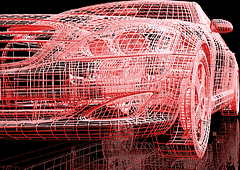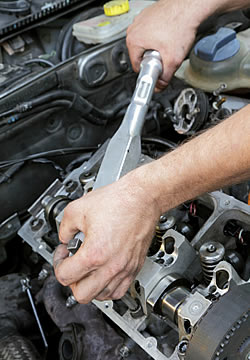Car Safety Information
- Why should you replace your camshaft/timing belt?
- Tyre Wear and Performance
- Tyre Pressure
- Brake Safety
WHY SHOULD YOU REPLACE YOUR CAMSHAFT/TIMING BELT?
The Cam Belt is a vital part of an engine that connects several moving parts allowing an engine to work. To explain its importance, imagine you are riding your pushbike when the chain comes off or breaks - you stop! It's the same with the cam belt on a car.
The difference between the two is that a bike chain is easy to replace and does little damage if it breaks or comes off. However, if the cam belt breaks or comes off, it causes serious damage to the car's engine, which in turn will lead to an expensive repair bill!
You rarely get any warning, hear any noises or feel any symptoms - the car just grinds to a halt usually with a loud rattle and clouds of smoke!
Because cam belt failure is such a problem, manufacturers give specific intervals for their replacement.
Your manufacturer will insist that the cam belt on your car is replaced once its engine has travelled a specific distance (a typical example is 40,000 miles), OR it is replaced once it has reached a certain age (a typical example is 4/5 years). Failure to do so can result in cam belt failure and a potentially expensive repair.
If the cam belt fails the result is immediate loss of engine power and no power to assist the steering or servo to assist the brakes. This is a potentially very dangerous situation and in risk terms similar to a burst tyre in that the higher your speed the greater the danger.
Our advice when buying a NEW car is simple, first check with your dealer when the cam belt should be changed (i.e. age and mileage), then sit back and enjoy your car. When the time comes, call us and we will change the cam belt and make sure it is recorded in the service log.
When buying a SECOND-HAND car our advice is slightly more complicated:
1. Note vehicle mileage and check to see if it should be changed.
2. For information as to when the cam belt was last changed, check the service book, under bonnet and on engine.
3. If there is no record of a cam belt replacement, always assume it has not been replaced. Although it may be possible to gain access to inspect the belt, it will not be possible to visually assess its condition to ascertain its future life.
4. If the vehicle's cam belt exceeds the stated change and/or has travelled a distance within a few thousand miles of stated change, CHANGE IT NOW!
TYRE WEAR AND PERFORMANCE
Though the legal limit is 1.6mm, tyre performance - particularly wet grip - gets worse as the tread wears. We recommend replacing tyres once the wear has reached 3mm as a basic safety precaution and particularly with the coming of the wetter autumn and winter months.
Most German cars are very high performance vehicles and driving with tyres near the legal limit compromises your safety and that of your passengers and other road users. It is a false economy to drive until the tyre wear reaches 1.6mm.
TYRE PRESSURES
An under or over inflated tyre can affect several aspects of your motoring. It can seriously reduce its life span, lower the fuel efficiency of your car and affect your car's road handling and braking.
The easiest and most cost effective method of checking your pressures is to use the public air compressor that you should find at your local petrol station. Along with this there should also be a chart on the wall with information about tyre pressures for the majority European makes and models. If not, the correct pressures for your own car should be in the vehicle's user manual or noted on the inside of the petrol flap or door pillar.
NOTE: Make sure that you have the correct pressures in the front and rear tyres of your car. Many modern vehicles' tyre pressures will differ between the front and the rear.
SAFETY NOTE: Your tyres are extremely important to the efficiency of your car and also your safety and that of other road users. Driving with over or under inflated tyres is dangerous. If you have found any damage or wear make sure you get the tyre checked and replaced as necessary as a matter of urgency.
We at The German Motor Company use a number of different tyre suppliers and will always endeavour to obtain competitive prices from top range 4x4 tyres to budget range Polo tyres. Why not contact us with your tyre sizes and let us quote?
BRAKE SAFETY
Most modern cars are fitted with Disc Brakes.
Two brake pads are contained in the brake caliper with their friction surfaces facing the brake disc that rotates at the same speed of the road wheel. When the brakes are hydraulically applied, the caliper clamps or squeezes the two pads together into the spinning disc to slow/stop the vehicle. When a brake pad is heated by contact with a disc, it transfers small amounts of friction material to the disc, turning it dull gray. The brake pad and disc (both now with friction material), then "stick" to each other, providing the friction that stops the vehicle.
Consequently brake pads wear on a regular basis and most manufacturers have incorporated a sensor embedded in the friction material which when it wears to the safe limit contacts the disc and causes a warning light to appear on the dashboard.
Worn pads should be replaced at the earliest opportunity before the friction part of the pad wears away completely and the metal backing of the pad contacts the metal of the disc ('metal to metal') which causes damage to the disc which will then also have to be replaced.
Apart from compromising safety, the cost of replacing a disc compared to just the brake pads on the front wheels of a modern Golf is in parts terms approximately £45 for a set of pads (x 4) and £90 for discs (x 2)for two wheels with a significant increase in labour charges.
Brake wear will vary on how the vehicle is driven and the brakes applied. On an average car driven sensibly brake pads usually require replacement at approximately 20000 miles intervals and discs approximately every 40000 miles.
Brake components should always be replaced as a matched pair on the same axle. It stands to reason that brake pads wear at approximately the same rate on each wheel but replacing one side only will cause uneven braking which could be dangerous in an emergency situation.
The brake warning light on the dashboard can illuminate for other reasons and when this occurs the car should be brought to us at the earliest opportunity.
Apart from checking brakes and other safety equipment when we service vehicles we also check the brake fluid level in the brake hydraulic system. The brake warning light can come on when the fluid level drops and the cause of this requires urgent investigation. Any loss of fluid compromises the efficiency of the brakes and poses a serious safety risk.

